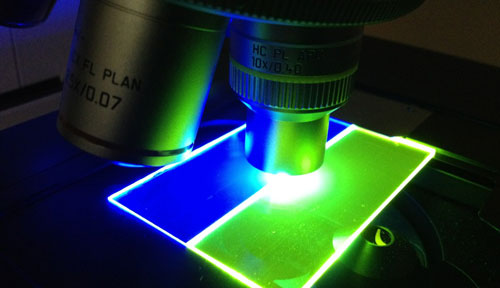The UNMC Tissue Sciences Facility (TSF) core has moved to Durham Research Center, Room 1052.
Volume has increased with the more visible location.
“We tried to shut down for three days to move,” said facility supervisor David Wert. “That didn’t work.”
Location, location, location
But it is hoped putting the TSF with the rest of the cores will make it more convenient for UNMC’s research community.
And the TSF has new equipment and technology to better support basic and specialized histology and immunohistochemistry for studies on animal and human tissues.
A better fit
Because the TSF is able to devote its focus to these activities, “The quality is better,” when compared with a lab that might do these tasks on top of everything else, said Geoff Talmon, M.D., TSF director. And, he said, with the TSF able to deliver services at cost, the prices are better too.
Services include:
- Tissue processing;
- Slides;
- Staining;
- IHC;
- Frozen slides;
- Scanning and more.
Better technology means fewer errors
“From start to finish we can do pretty much anything,” Wert said. With TSF’s new Leica BOND-MAX, “User errors are taken out.”
High-resolution scans of tissue slides ensure consistency, and researchers can view them on laptops, rather than microscopes.
“It’s permanent. It’s transferrable. You can analyze it with software. You can use the images for publication,” Dr. Talmon said. “You can share this on the Web.”
A clearer picture
Florescent slide scanning allows researchers to look at many factors at once.
Stop by DRC 1052, contact the TSF or go to http://www.unmc.edu/pathology/tissue_sciences_facility.htm to learn more about the TSF.
